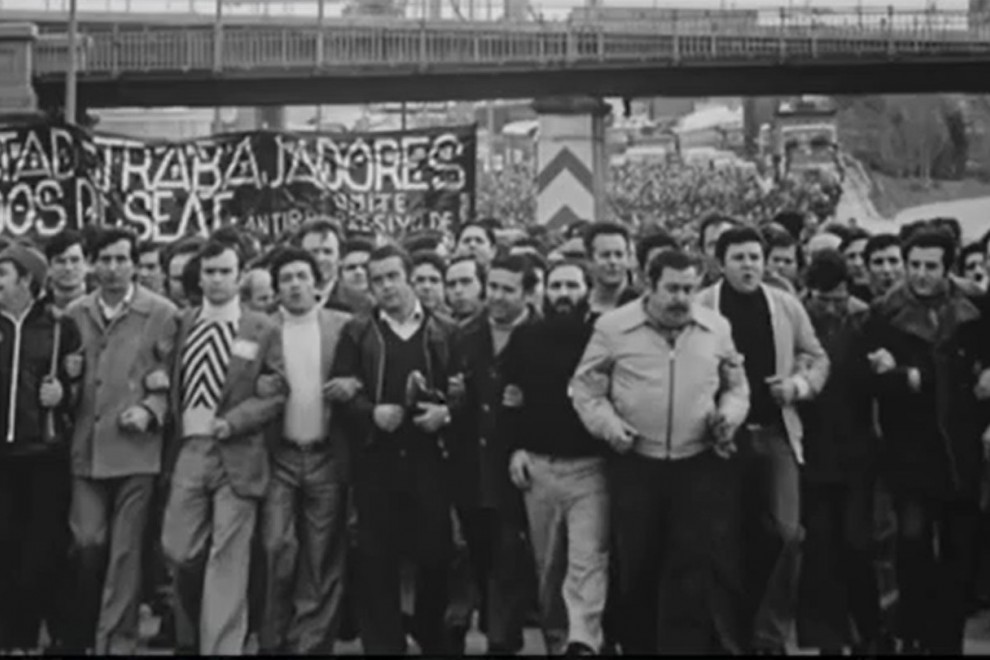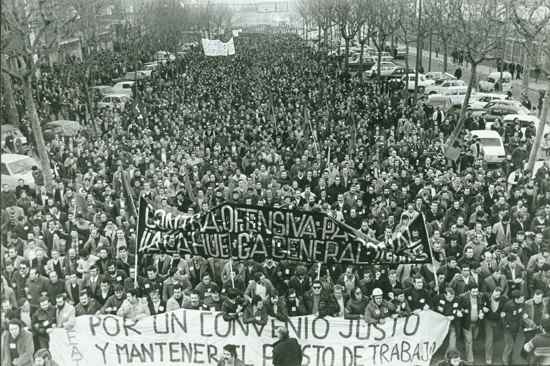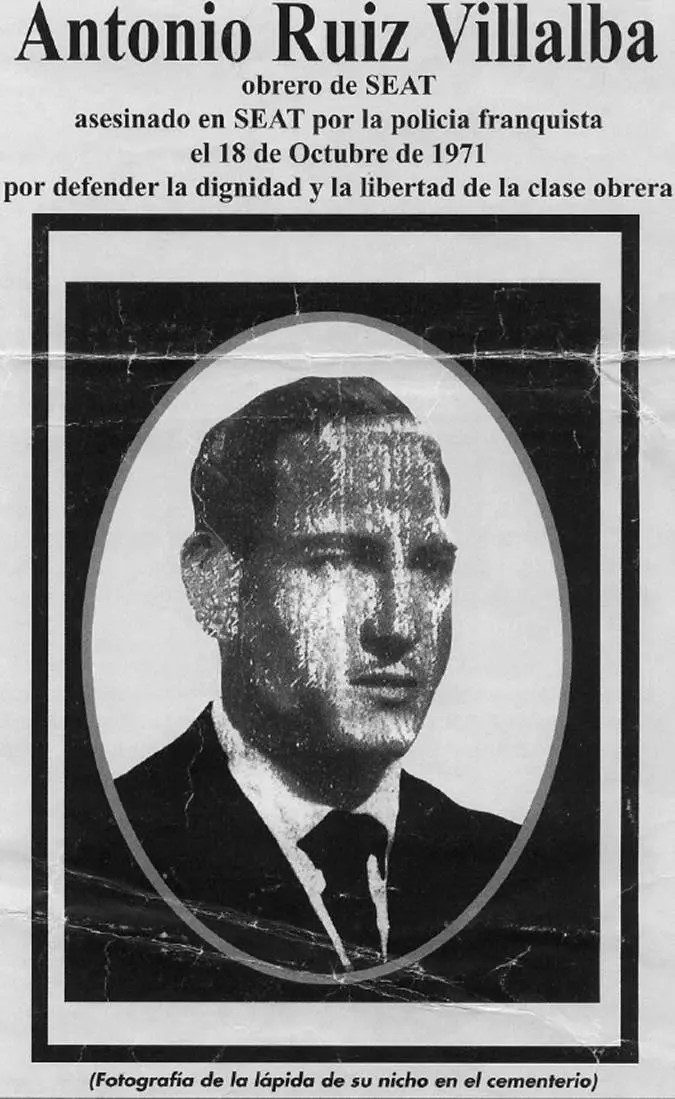The deadly 1971 strike at one of Franco’s biggest corporate institutions
Violent repressive response from state shows rights must always be defended, activists say

Despite strikes being outlawed during the Franco dictatorship, there were still many examples of workers standing up against injustices, putting their own lives and safety at risk, to fight for a better future.
In 1971, thousands of workers at one of Spain’s biggest factories shut down operations in response to the company’s decision to fire union leaders. There, on the factory floors of one of the strongest corporate institutions of Francoism, they were met with violent police repression that saw one worker killed.
The strike sent ripples across Spanish society and led to a political awakening among many, which served to strengthen the thirst for freedom in the latter part of the Franco dictatorship.
More than 50 years on, Antonio Ruiz Villalba’s death still serves as a reminder that fascism must be confronted and that rights must continually be defended, as some of the leaders of the strike point out.

Origins of the strike
Pedro López Provencio was a technician working in the factory of car manufacturer SEAT when in the early 1970s he and some of his colleagues put themselves forward to stand in the trade union elections. At the time, the union, known colloquially as the ‘Sindicat Vertical’, operated in all industries and served the interests of the regime rather than the workers, and López had become fed up with the lack of progress whenever there were issues.
After already having held assemblies to let workers voice concerns and discuss problems for months prior to the union election, Pedro and his comrades were all chosen to represent the workers’ interests. Their first major point of contention with the management would come in 1971 when on a day’s notice, one third of a workshop was ordered to switch to night shifts from the following day, with the same level of output expected from the remaining workers.

Pedro and his fellow representatives argued the case with SEAT management, who responded by firing the union leaders. The case was brought to the courts, which Pedro and his colleagues even won, but still the company refused to reinstate them to their positions.
Violent police response
Anger and frustration grew. The cause for industrial action shifted from the night shifts to standing in solidarity with their arbitrarily dismissed colleagues. Concurrently, these feelings were mixed with frustration of a lack of freedoms and a low standard of living as a whole, as during the Franco dictatorship it was impossible to separate work life from the political sphere and all of life in general.
After some weeks of deliberation, the workers decided to act, and organized a strike for October 18, 1971.
The organizers of the strike took advantage of the shift change to ensure as many workers as possible would be there to shut down operations in one workshop after another and stand up to the company representatives together. “Inside, we declared a strike in the entire factory,” Pedro López tells Catalan News.

At the time, SEAT had around 24,000 workers in the Zona Franca factory, and over 10,000 of them took part in this occupation, demanding the fired workers be reinstated. The company refused, and instead sent in the police.
“They began to throw tear gas. At first, people threw it back, but then there came a moment when you just couldn’t breathe in there,” Pedro says. An all-out battle broke out throughout the factory. “In workshop 5, the workers tried to leave but there they found the police cavalry waiting, three or four dozen horses with police and raised batons.”

“They charged at us brutally. Many workers had picked up objects to throw and some had iron bars and were throwing them at the horses and police. Many workers came from the countryside and knew how horses were, so picked up balls of tar to make a sticky substance to make them slip.
Twelve hours of brutal battle followed. “I think there must have been 500 police, between those on horses, on foot, with tear gas, a helicopter,” Pedro estimates, “and they just wouldn’t let anyone talk.”
Pedro didn’t expect the police to react as strongly as they did. “From the faces some of the police made, they seemed to be more afraid than we were, and weren’t too sure what they had to do, but well, they were following orders.”

“Amid all this, we found out that there had been gunfire and that it seemed a comrade had been killed. People were very angry and wanted to burn things, and I had to tell them no. This particular comrade, Antonio –who never stood out as a prominent member of the union or for organizing or for speaking at assemblies or anything– well, he was the one who was killed,” Pedro says.
“We think it was a police officer who fell off his horse, and probably Antonio approached him to help him, and the policeman, being more afraid than we were, shot him in the stomach.”
Legacy and commemorative plaque
The strike provoked a political awakening among many SEAT workers who previously were not actively engaged in politics, Pedro López says. After witnessing the violent response of the state and the unwillingness to negotiate, they felt the injustices of the political system even stronger and understood the need to stand up and force change.
The following weeks saw numerous protests against the excessive police violence held in Barcelona among SEAT workers.

The demonstration also had an impact across the country, as people up and down Spain saw the workers of SEAT, a model of the Franco regime, rise up. From its founding, the choice to build SEAT in Barcelona, a city with such a strong history of workers’ movements, was already a risky one for the dictatorship, and as such, many hardline Francoists were installed in higher positions of the company to strengthen it against any possible movements from below.
For such a company to experience such a tumultuous strike, with follow-up protests lasting weeks after the initial strike, was a blow to Franco.
In 2021, the Barcelona city council commemorated the killing of Antonio Ruiz Villalba and recognized the struggle of the SEAT workers with a new plaque in Plaça del Moviment Obrer – Workers’ Movement Square. The violent repressive episode is now a landmark in the labor and antifascist struggle in Barcelona.
"Rights are not definitive and must be defended every day," recalled trade union activist Carles Vallejo, another of the fired SEAT workers who helped organize the strike.

"Not long ago we were suffering from a dictatorship, and it was the citizens, the workers, and the neighbors who mobilized to conquer and fight for rights that we didn't have," Vallejo told the Catalan News Agency at the inauguration of the plaque in 2021. "Rights are not definitive and must be defended every day."
"What is normal today, such as being elected union delegate, negotiating agreements or gathering for a meeting, used to be a crime," the activist pointed out. "Because of this, many of us ended up in prison and others died.”
“Now that the seed of fascism is returning, it’s a moral obligation, for those of us who fought in these battles to give our testimony, but also for the institutions, to ensure that this kind of fascism doesn’t return.”